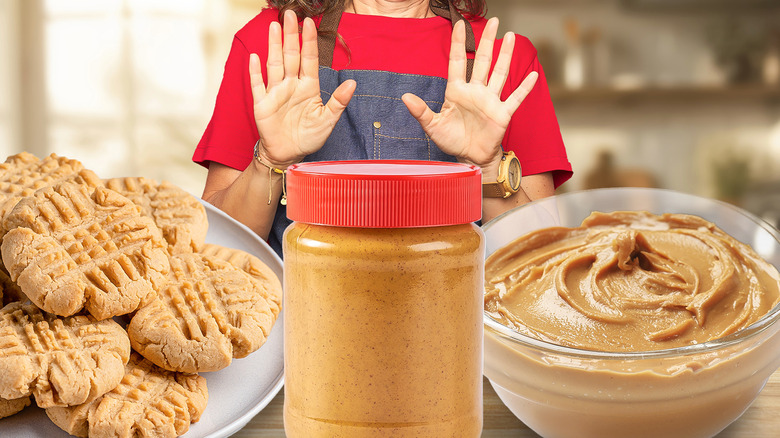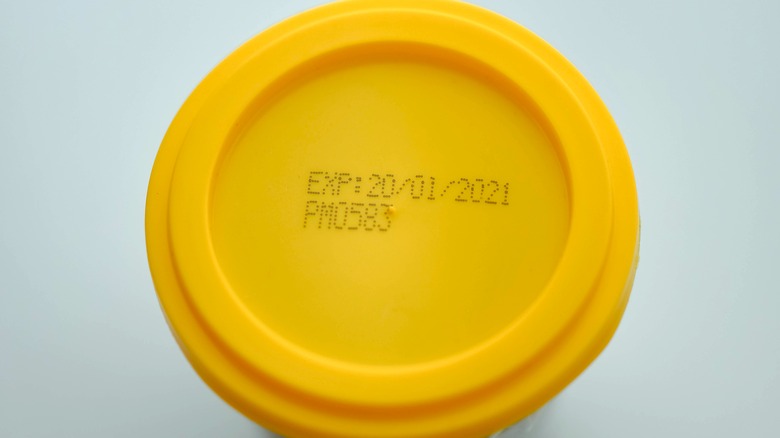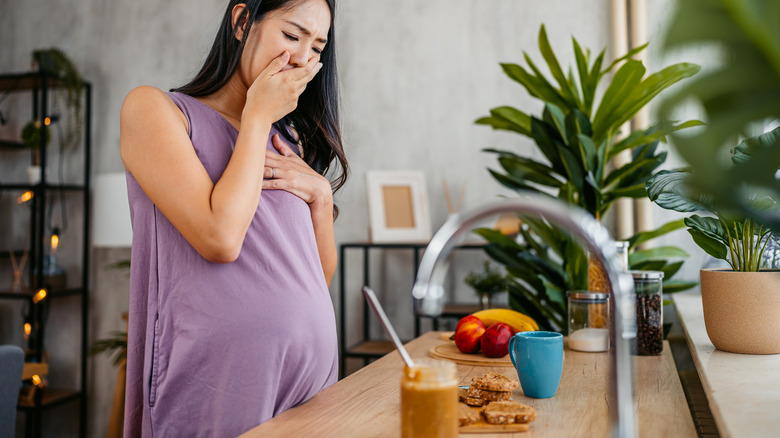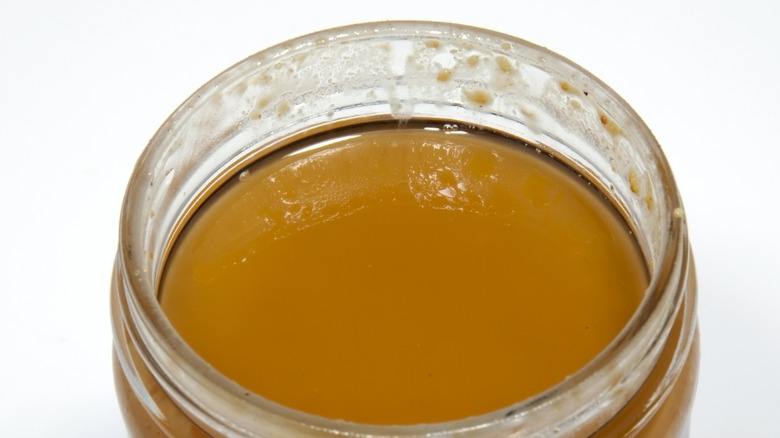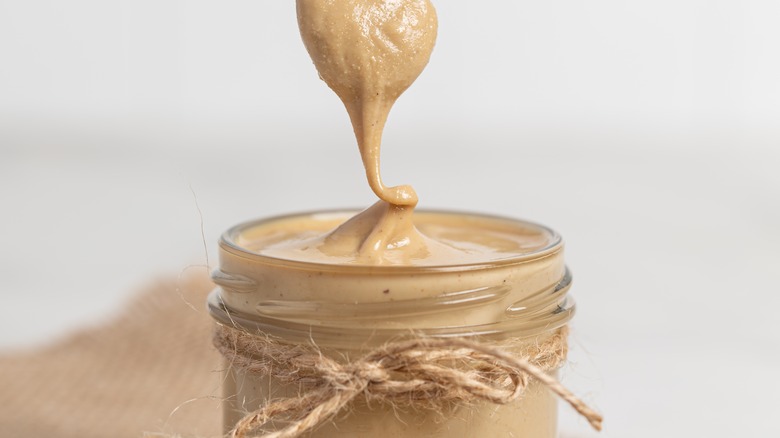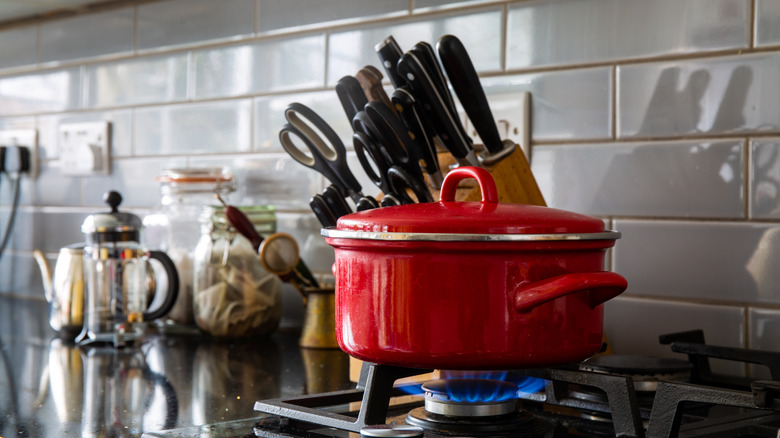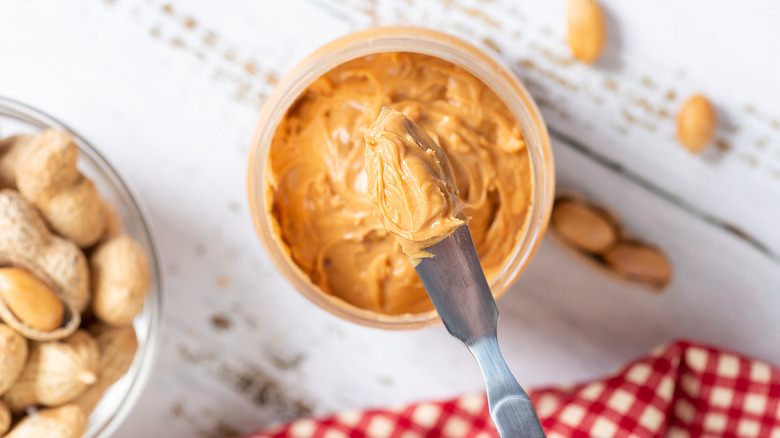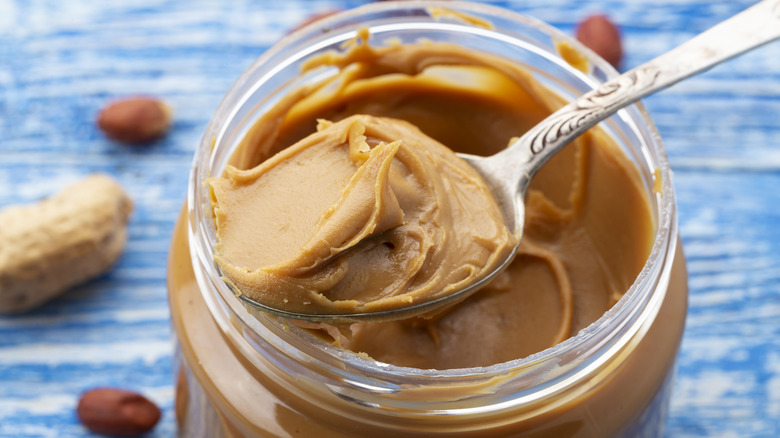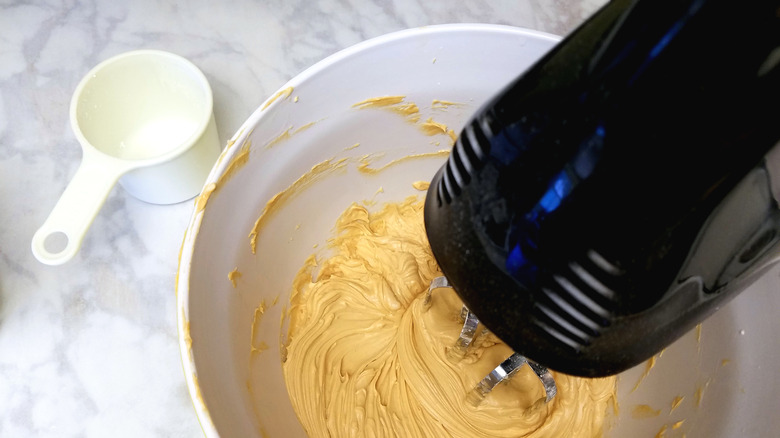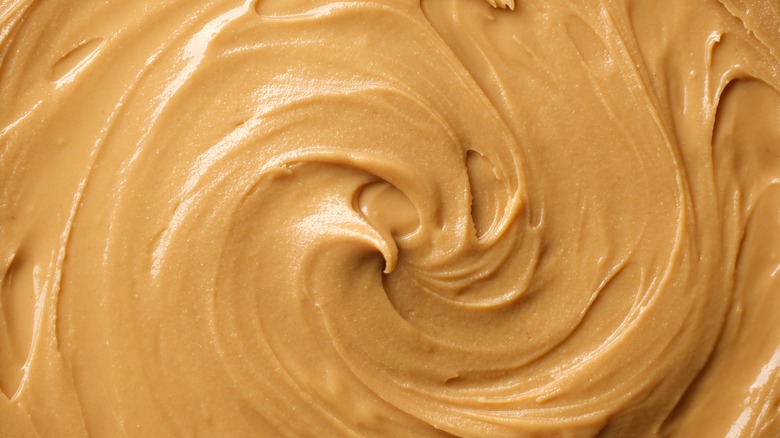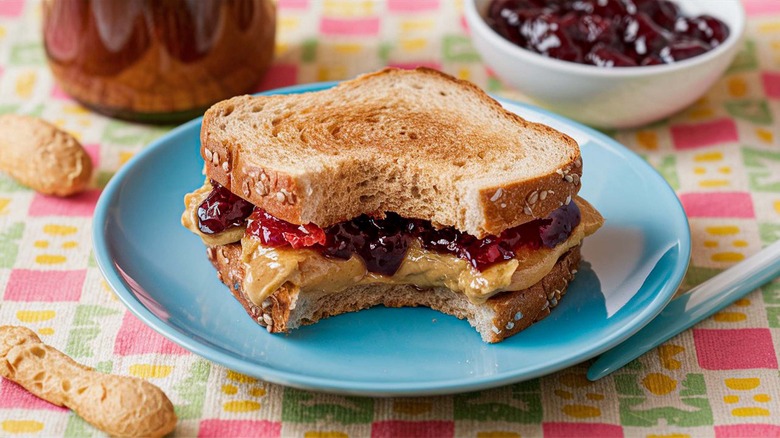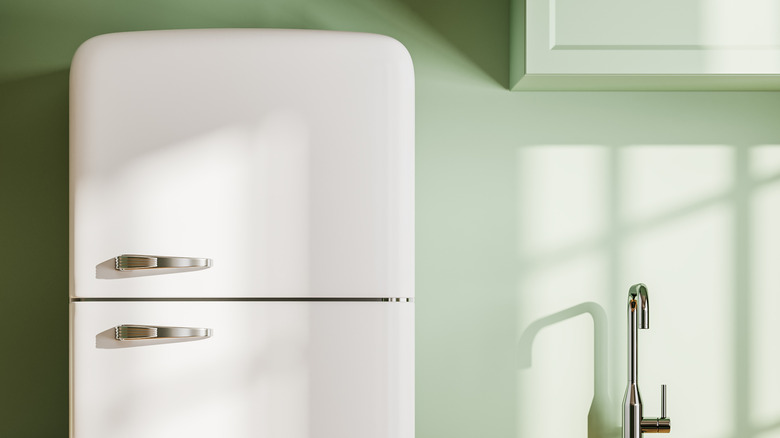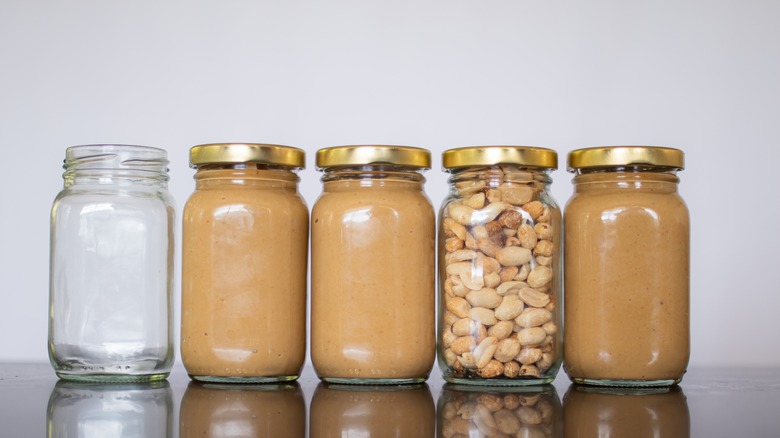You Need To Stop Making These Peanut Butter Mistakes
Peanut butter is such a storied pillar of Americana that it seems everyone has their own traditions for using it. For instance, it is a 100% foolproof hiccup cure in this writer's household. (There's no scientific evidence to back this up, and you should be careful shoving gobs of nut butter into a hiccuper's mouth, but seriously ... it works.) More pertinently, peanut butter is half of the classic PB&J and the basis for many a delicious dessert, from cookies to rich, banana-flavored Elvis cake.
Impressively for such a humble food, peanut butter has also firmly split the public across many vectors: creamy versus chunky; sweetened versus not; refrigerated versus cabinet-stored. It's almost like it's here to cause us trouble, when we all know its true purpose is to spread joy. (Get it? Spread?) Which is to say, there's more than one peanut butter myth out there you need to part with.
The same is true of peanut butter mistakes, of which most people make a good number. Happily, this post is here to correct them for you. Chowhound sat down with a few cooking experts to find out exactly how to buy, store, handle, and cook with this most beloved of American foods so you don't have to make such errors ever again.
Failing to check the label
Chances are, if you've been around for a decade or two, you already have some pretty firmly-held peanut butter brand preferences. A lot of them, unfortunately, contain more junk than we'd like to think, from palm oil to excess sugar and beyond. Moreover, it's not enough to know which peanut butter brands you should buy and which you should avoid; you also need to know what's going on inside your jars.
"One of the biggest mistakes in choosing peanut butter is overlooking the ingredients list," says Marissa Stevens of the recipe blog Pinch and Swirl. "The best peanut butters often have just one or two ingredients: peanuts and maybe salt."
Many have added sweeteners as well. You may like sugar in your PB; you may not. Either way, you should know what you're getting, so make sure to check the label. While a little honey or maple syrup is fine, if that's what you enjoy, look out for hidden sugars in the form of agave, molasses, and dried cane syrup.
Forgetting the expiration date
Peanut butter seems like one of those apocalypse-proof foods, but it is subject to the sands of time like everything else. "Remember that peanut butter has a shelf life," cautions Joanne Gallagher, half of the cooking duo behind Inspired Taste. For that reason, you should always check the expiration date before you buy it and before you use it.
One of the main reasons the expiration date is so important is that peanut butter is full of oil, and oil goes rancid. More than other shelf-stable foods, peanut butter is sensitive to age and can go off quickly. As such, don't just make sure the jar is within its useful window; you want to look for the longest shelf life you can find.
It helps to know exactly what all those numbers mean. The date you see will be listed as "best by," "sell by," or "use by." The first defines the optimum window for use, the second is the time period by which the store should move the product, and the third is the cutoff for when you, the consumer, can expect the best quality. However, it's worth noting that expiration dating is mostly voluntary, a courtesy that food companies provide.
Using it despite iffy smells
Again, peanut butter has lots of oil, so eventually, it will go rancid. If it smells off, it is off, so you should discard it right away. That's true even if it's still within its best-by date, says Joanne Gallagher, adding that there are other ways to tell it has gone bad as well. You should also discard it if it smells fine but tastes funny, and definitely get rid of it any time you see mold. (For the most part, the idea that you can just scrape away the mold and eat the rest is a myth.)
Homemade nut butters, with their variable amounts of salt and other flavorings, may go off sooner than those you buy in airtight jars. If you make your nut butter yourself, you should be even more careful about smells, and don't use it if there's anything funky going on.
Treating natural and processed peanut butter the same
It is a mistake to treat a jar of organic, peanut-only spread as equal in nutritional value to a jar of Skippy. To be fair, peanuts and peanut butter have the potential to be very good for you. Research indicates they may aid in regulating your blood sugar, keeping cholesterol in check, and supporting your heart. However, the other components you'll find in many peanut butters are less healthy, such as sugar, palm oil, and other emulsifiers.
Plus, processed peanut butter is a different animal than natural peanut butter in terms of usage and cooking. It already contains additional fats and sugars, so you may need to adjust recipes accordingly. This is especially true for baking, where the delicate chemistry can be affected by ingredient substitutions. If you do want to substitute, know there exist any number of peanut butters on the market, and many are shockingly similar to other brands and recipes (looking at you, Trader Joe's PB dupe from Costco).
Freaking out about separation
"I'm often asked why natural or homemade peanut butter separates," says Joanne Gallagher. "Natural and homemade peanut butter typically consists of just peanuts and sometimes salt, while regular peanut butter usually includes other ingredients like sugar, oils, and emulsifiers (like soy lecithin). The emulsifiers prevent the natural separation of peanut oil from the solids, creating a consistently smooth texture in regular peanut butter." Trust that without palm oil or another emulsifier, you're going to see that distinct oil layer on top.
Now, emulsifiers are great at what they do: blend together liquids and oils and keep them blended. They prevent the peanut butter and oil from naturally pulling apart, a process known as syneresis, which will happen over and over again in the absence of an emulsifier, no matter how many times you stir. However, the ones used in peanut butter (such as palm oil) aren't great for you. If you want to go natural, you'll have to accept separation as normal, but there's a hack out there to help you.
Failing to stir natural peanut butter well
It's important to stir natural peanut butter well before you use it, otherwise you will get tons of chunky bits within the runny, saucy peanut oil. This is one of the biggest mistakes home chefs make and is often the reason they get turned off by natural peanut butter in the first place.
If you'd rather not have to stir a jar of natural peanut butter while just trying to make a godforsaken sandwich, though, good news: there's a better way. The electric beater trick will save lives. All you have to do is take your hand mixer, insert only one beater, and stick that into a jar of just-opened natural peanut butter. Et voilà: a mess-free solution.
A related mistake is not stirring natural peanut butter thoroughly before refrigerating. "This can lead to rock-hard PB at the bottom and a pool of oil on top," Marissa Stevens says. So if you're going to store it in the fridge (more on that below), then go ahead and give your peanut butter a good stir first.
If you're sick of stirring natural peanut butter in any way, period, you might want to try the upside-down trick. This requires you to simply upend your jar of peanut butter in the cupboard, then leave it that way for 1-3 days. This will distribute peanuts and oil, making it easy to mix with a vigorous shake of the jar. Continue to flip it whenever you see oil forming.
Cooking it at too high a temperature
While some home chefs may assume peanut butter has a high smoke point, they are probably thinking of peanut oil, which doesn't burn until it reaches a temperature of 450 degrees Fahrenheit. That's well and good, but peanut butter has additional ingredients beyond oil, so it doesn't share peanut oil's hardy tolerances. In fact, peanut butter burns easily. "It's best to use low to medium heat and keep a close eye on it to avoid scorching, which can ruin the flavor," Joanne Gallagher says.
Moreover, don't walk away from the stove. Peanut butter's low smoke point means that it can quickly go from Just Fine to Completely Ruined. Make sure you're always watching it if it's on the heat. This isn't a concern in baking or roasting in quite the same way, because the peanut butter is mixed with other ingredients and the heat is much better distributed.
Using chunky PB for peanut sauce
Peanut sauce should be smooth, full stop. There are no sane dissenting opinions here. All the best recipes use creamy even if they don't specifically instruct you to, because chunky nuts are just weird. Who wants a big nut crunch when they're trying to enjoy a silky-smooth sauce on noodles or veggies? For that reason, Marissa Stevens says, "When making peanut sauce, stick with creamy peanut butter."
Plus, she adds, "Chunks can interfere with the smooth texture you're typically aiming for." They may make it more difficult to stir together other ingredients too, leading not only to ill-distributed peanut flavor but to a poorly mixed overall result. For the best possible sauce, you can use either natural peanut butter or a spread with other ingredients, and you can even use other nut butters (think sunflower, cashew, or almond). The sky's the limit, as long as your picks are smooth.
Using peanut butter straight from the fridge when baking
If you're a fridge-storing peanut butter owner, then you already know that sucker comes out much denser than its cupboard-stored counterparts. There's a reason for that. "Peanut butter's consistency changes with temperature," Marissa Stevens says. "Room temp is perfect for spreading, while slightly chilled works better for no-bake treats and is great for making protein bites." However, she says, if you're going to bake with peanut butter, it's important to let it come to room temperature first. "Cold peanut butter doesn't incorporate well."
Most likely you've already encountered this concept, as many recipes will tell you to let your ingredients (butter, eggs, etc.) come to room temperature. If you, like this writer used to, routinely ignore that directive, then you're missing out on the best possible results.
Why? Back to emulsion science. When you allow your ingredients to come to room temperature, they can then blend smoothly with other ingredients, enabling them to trap the air that forms during the baking process. If they are cold, though, they won't blend as well and your goodies won't come up fluffy like they should.
Blending incompletely when baking
Related to the above idea, you've got to make sure your peanut butter is nice and smooth before you try to bake with it. It's a mistake to let yourself believe that chunks will simply melt into your baked goods ... they won't. Even if peanut butter is at room temperature, if it isn't a creamy consistency, you will get subpar results from your baked goods.
Joanne Gallagher recommends thoroughly blending or whisking it with other ingredients to avoid clumps. However, it's best to do so with other liquids since overbeating flour can develop gluten and create a tougher final result.
Admittedly, peanut butter can be hard to incorporate with other ingredients, especially if it isn't smooth to start with, so make sure it is. If you really can't get it to blend nicely by hand or when using the beater trick, pop the whole gob of nut butter in the food processor and go to town.
Thinning peanut butter improperly
Sometimes you find you simply can't incorporate your peanut butter into a nice spread no matter what you do. This is especially common with natural peanut butter, whose bottommost inch or two tends to turn into a mineral-esque crumble-sludge that looks like anything but food. When this happens, you must either abandon it or thin it out. It's possible to do the latter, but you must do it in the right way.
The first tip is easy: add a little water. However, you can also easily overdo it and end up with something that looks less like nut butter and more like sauce. (Though hot tip: a 50/50 mix of water and peanut butter makes a great dip for apple slices, this writer has found.) Warm water will also get peanut sludge out of the bottom of the jar, since heat helps to loosen the nut butter even more. Popping it in the microwave will make it even runnier.
You can also try adding a little bit of oil and mixing or processing the butter until it becomes creamy and smooth once more. Ideally, you should use peanut oil for the best flavor match. (Incidentally, this works for any nut butter and oil combo: almond butter and almond oil, walnut butter and walnut oil, etc.) But really, any neutral-tasting oil will do. Try canola, vegetable, or grapeseed oil if you don't have the peanut variety.
Not making toasted PB&Js
The peanut butter and jelly sandwich seems like such a mainstay in American cuisine (did you hear the air quotes around "cuisine"?) that it's hard to imagine it ever had to be invented. But it was, way back in 1901, and has been the recipient of culinary experimentation ever since. Bet you didn't know there are several ways to update the classic peanut butter and jelly sandwich.
The best and easiest way is to toast the bread first. "The warmth slightly melts the PB, and the textural contrast is amazing," says Marissa Stevens. Plus, pretty much everyone has a toaster and two minutes to spare. If you want to graduate to more complex PBJ updates, try grilling your sandwich in a tablespoon of butter.
There are countless other upgrades, of course. You can add marshmallows for fluff, peanuts for crunch, whole grain bread for nutrition, or seasonal jam for novelty. You could use Nutella in place of peanut butter, stick some bacon between the bread slices, or sub out sandwich bread for Southern-style biscuits. Fresh fruit can liven things up, while coconut flakes, granola, or chia seeds add textural interest. Really, if you're not experimenting with your sammies, who even are you?
Not freezing it
Turns out, peanut butter freezes super well. Understanding how to do so properly can help you avoid wasting food and money. "It's a great way to extend its shelf life, especially for natural peanut butter which tends to separate and go rancid faster than processed varieties," Joanne Gallagher says. "Before freezing natural or homemade peanut butter, give it a really good stir. Once frozen, you can keep it in the freezer for up to six months, then when you need to use it, thaw it in the fridge overnight or add it still frozen to smoothies."
The easiest way to freeze peanut butter is in its own jar, but many other options work too. "I like to portion it into smaller, freezer-safe containers or ice cube trays," Gallagher says. "That way I can take out as much as I need when I need it." You can also portion it into airtight containers smaller than the jar but larger than an ice cube, if you wish. Just make sure to give it a good stir once thawed, Marissa Stevens adds.
Storing it in the pantry
A final mistake when it comes to peanut butter is storing it in the pantry. Peanut butter in the pantry is likelier to go rancid than in the fridge. This is especially true for natural peanut butter, whose oils separate and are even more likely to go off quickly, Marissa Stevens says. And then, of course, there's the fact that refrigeration halts separation.
It's worth noting that conventional peanut butter will stay good longer in the cabinet, without refrigeration, because it contains stabilizers and preservatives that natural peanut butter does not. (At best, natural peanut butter only has salt, which does extend shelf life somewhat but not like preservatives or sugars.)
However, the fridge will extend the shelf life of all peanut butters considerably, no matter their provenance. According to the National Peanut Board, unopened peanut butter will last 6-9 months in the pantry. Opened peanut butter only lasts 2-3 months in the pantry but 6-9 in the fridge ... and that's the kind with preservatives. If you're not going to go through a jar in two months or less, it's definitely time to switch tactics.
